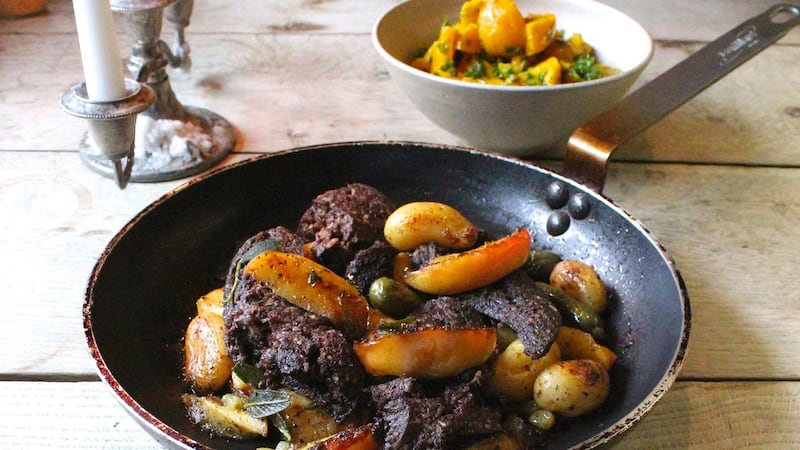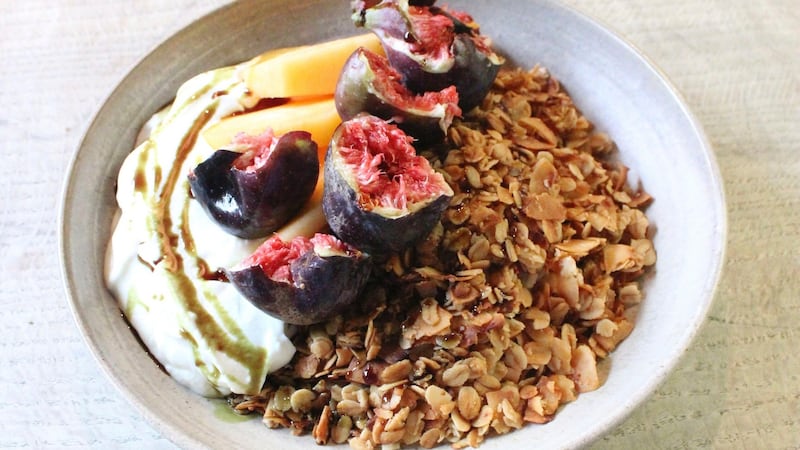In the late 1990s, when I was growing up, posh coffee was something alien to us, and no one was roasting their own beans. That’s when they invented the flat white, and back then eggs Benedict flew out the door. Every 15-year-old kitchen porter in New Zealand knew how to make a decent hollandaise sauce for them. So obviously, when we opened Kai, our restaurant in Galway, I relived my youth a bit and whacked on some old classics.
When you talk about signature dishes, Paul Flynn has his crab brulee, Julia Child her coq au vin, Seiji Yamamoto his hamo eel soup – but at Kai we have our fish fingers. This dish was originally my other half’s party piece after late-night antics in the city’s Westend.
The reinvention started when David and I were really trying to change to buying fish more responsibly. Who in their right mind would buy pollock in a restaurant? But you would buy a beautiful fish finger tarted up with a beautiful preserved-lemon aloli, trendy slaw and hunk of freshly made brown soda with a slab of Cuinneog country butter. The fish-finger legend lives on.

CHUNKY OVEN POLLOCK FINGERS
Home-made fish fingers have more fish, more flavour and more crunch than shop-bought ones and are well worth the effort. I always make some extra to freeze. They make a brilliant midweek emergency supper, cooked in batches from frozen. Serve them with crispy home-made oven chips, or between two slices of bread with loads of tartare sauce for the ultimate fish-finger sandwich. We are using pollock here, but any white fish, such as ling or plaice, would do just as well. Sustainable white fish, such as coley, would be even better. Panko crumbs give the nicest coating, but we nearly always have breadcrumbs in the freezer, so that’s normally what I use. Either is a vast improvement on the bright-orange coating of the boxed fish finger – sorry Captain Birdseye, no offence intended.
Ingredients
2 pollock fillets (skinned)
70g flour, seasoned
100g white breadcrumbs (or panko)
2 eggs, beaten
Salt and pepper (to taste)
Method
Cut the fish into strips down the fillet, following the natural lines of the fish.
The strips should be about 2cm wide and 8-10cm long. Sprinkle some salt on to the fish.
Put the flour into a shallow bowl and season with salt and pepper. Put the breadcrumbs or panko into another shallow bowl, and beat the eggs in an additional bowl.
Dip each finger in the seasoned flour, coating it well, then in the beaten egg, and finally in the breadcrumbs. Doing it in this order will keep one hand for the dry ingredients and the other for the wet one. (At this point you can freeze them on layers of baking parchment in an airtight container.)
Lay on a roasting tray lined with greaseproof paper that has been brushed lightly with vegetable oil. Roast in a hot oven for 12-15 minutes, until crisp and golden. Carefully remove from the pan and serve with tartare sauce or simply mayo with a good squeeze of lemon.
YESTERDAY’S POTATOES, JOHN’S BLOOD SAUSAGE AND ROASTED APPLES

If you’re getting bored with the typical full Irish breakfast but still need your black pudding, then this is the recipe for you. The apples lend sweetness, and the potatoes will keep you going until lunchtime. The curley parsley adds a 1970s vibe.
Ingredients
200g of your favourite local black pudding (ours is from John Herterich, the Galway pork butcher)
300g of last night's spuds
2tbsp olive or good rapeseed oil
1 medium onion (chopped)
2 lovely Cox orange pippins, cored and sliced
1 small handful of cornichons
2-3tbsp curly parsley (chopped)
Method
Heat the oil in a large frying pan, add the drained potatoes and fry them for about four minutes, until they start to brown.
Add the onion and apple, continue to cook until soft. Season well with salt and pepper.
Roughly chop the black pudding, add it to the frying pan, stir and cook for five minutes until piping hot and beginning to crisp, then add the cornichons.
Cover the pan and cook over a medium heat for three or four minutes, or until cooked through.
Sprinkle with parsley and serve straight away.
ANZAC BISCUIT GRANOLA

Anzac Day is in April. If you’re not Antipodean, it is a public holiday of remembrance, so we don’t forget the sacrifices made in the war by members of the Australian and New Zealand Army Corps. These were the biscuits that were sent to our troops, because the ingredients of rolled oats, sugar, coconut and golden syrup were nutritious and didn’t spoil easily. If you’ve never tried one, give them a go, as they are delicious. This is the granola version. It’s all about the coconut.
Ingredients
350g rolled oats
75g coconut flakes
100g macadamia nuts, chopped roughly
100g almond nuts, roughly chopped
100g brown sugar
¾ cup apple juice
5 tablespoons golden syrup
1 teaspoon salt
Method
Preheat oven to 170C/340F and line a large or two small baking trays with parchment. In a large bowl, mix the oats, coconut flakes, nuts and brown sugar and stir to combine.
Heat the apple juice on the stovetop or in a microwave until warm and stir the golden syrup and salt into the juice. Pour half the juice over the oat mixture and stir to combine. Pour the rest of the juice and coat all the oats evenly.
Empty onto the prepared tray/s and spread out evenly. Bake for 20-25 minutes until toasty. Remove from oven and redistribute the cereal so that the oats cook evenly. Bake for another 15-20 minutes until everything is crunchy and toasted. When cool add any dried fruit if you like. Store in an airtight container.











